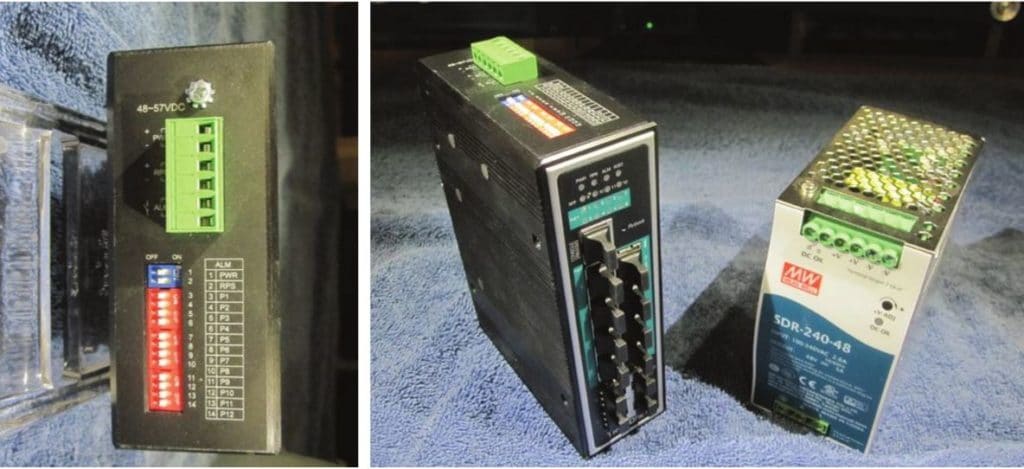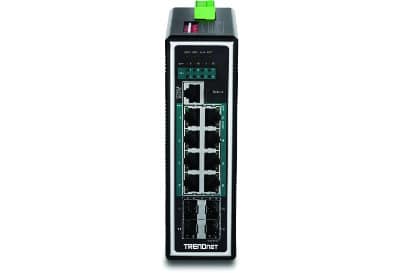The TRENDnet TI-PG1284i network switch is an attractive solution for locations that are less than ideal.
TRENDnet has introduced a new industrial-grade hardened network switch that promises to become a “go-to” component for installers when they have network locations that don’t have the best environmental conditions.
TRENDnet has been involved in the electronics world since 1990 and was founded in Torrance, Calif. The company has been building network solutions for the consumer, commercial and industrial markets, and today supplies many different solutions for its markets.
Today’s electronic networks whether they are designed and utilized for CCTV, access control, voice over Internet or some other network function, rely on several key components to complete their system designs.
Increasingly the network switch is installed in locations that can best be described as “less than friendly” to electronics. This review covers a switch that is designed to roll with the punches.
Construction
The TI-PG1284i network switch is constructed with a hardened metal casing and about the size of a hardback novel. The unit has a solid feel to it, shows good construction and has an IP30-rated enclosure that protects the internal components from external dirt and dust intrusion.
The unit is not immune to liquids so mounting it exposed outdoors is out of the question! The switch is designed for harsh environments and can withstand temperatures from -40° to 75° C / -40° to 167° F.
The switch has 12 network ports and one RS-232 port on the front panel. Of those 12 network ports eight are gigabit RJ-45 connections and four are GB SFP ports. The top of the unit has connections for the external power supplies (both primary and redundant) and the external alarm.
There are also addressable DIP switches that allow the end user to customize the notification alarms from the switch for every port and power connection. There is also a grounding terminal on the top of the case to provide greater protection from static shocks.
The TI-PG1284i relies on an external power source of 48VDC; the input voltage has a range of 48 to 57VDC with a rating of 240+ watts. This voltage can be supplied from a master power source or from a standalone unit.
For our testing, we were provided a complementary component power supply, Model TI-S24048, to provide the required input voltage. This unit, just like the switch, is designed to mount to a DIN rail to provide a secured installation.
The electrical wiring for the power unit connects to a Phoenix connector that allows the unit to be easily disconnected from its 120VAC power source should servicing be required.
Features
The TI-PG1284i can supply up to 30W of PoE/PoE+ power for its network ports. The power to each of these ports can be turned on and off via the web-based graphical user interface; this allows the user to remotely reset a device, which can be very effective for troubleshooting or refreshing field devices.
The inclusion of four SFP ports allows the switch to be connected to different devices via fiber-optic connections. This can allow the switch to be used as a hub or repeater for a fiber network; this can be very handy when there are different connection requirements for a network’s construction.
The inclusion of alarm outputs for each network port (as well as the power supply) provides an alert to the user that there is a system problem that requires immediate attention.
The switch is constructed to resist shock and vibration damage and has been rated for durability by the International Electrotechnical Commission (IEC). It also has a freefall rating which is one I have a hard time understanding since the unit is designed to be firmly mounted to a DIN rail!
The TI-PG1284i is also rated by the IEC to resist electrostatic discharges and electromagnetic interference. This makes the unit a perfect fit for installation in a congested environment where there might be heavy electrical interferences.

DIP switch configuration of the TI-PG1284i’s alarm outputs (left) makes setting up failure notification a breeze. The separate power supply (right) allows for redundant power where needed.
Setup and Testing
Upon unpacking the contents from the box, I found the unit is supplied with a six-foot RJ-45 to RS-232 cable, a quick installation guide, and a CD containing the full product manual and the quick reference guide.
For my examination and testing I performed a basic installation utilizing the switch, power supply, computer and PoE network camera. I used a fixed dome IP camera to test the PoE port switching that allowed me to switch the camera on and off as needed.
As noted, having the ability to reset a device remotely is a wonderful thing — think of the time and effort that can be saved by being able to remote in to the switch and perform this reset.
Compare this to grabbing your eight-foot ladder, slugging it through a back hallway and climbing up to a field node just to unplug a camera or other network device. This feature is worth its weight in gold to me.
The embedded GUI of the TI-PG1284i allows for many system settings within the network. While my networking experience is fairly extensive and has been put to the test many times, I must confess that I was not completely familiar with all of the arcane system settings of which this device is capable, according to the manual.
In addition to the web-based GUI for programming and control of the TI-PG1284i, the unit can be controlled via RS-232 commands from your computer for those “old-school” system administrators.
While I am not one who is well versed in command line interface (CLI) commands, I understand its usefulness for network professionals. Again, this switch provides the user with a plethora of options and protections.
Conclusions
The TI-PG1284i is a robust switch that will perform well in any system’s network. Its size, design and durability makes it a great unit for installation in varied environments, from a small field node in a hazardous location to a network closet with many switches configured together.
The TI-PFG1284i will make a welcome addition to any installer’s repertoire.
Verdict
- Features 1 2 3 4 5
- Construction 1 2 3 4 5
- Setup 1 2 3 4 5
- Performance 1 2 3 4 5
- Overall 1 2 3 4 5
First published in the March 2017 issue of Security Sales & Integration magazine.




